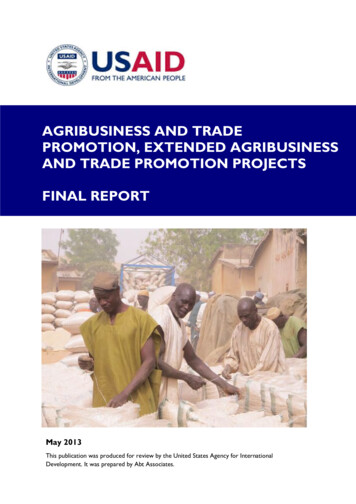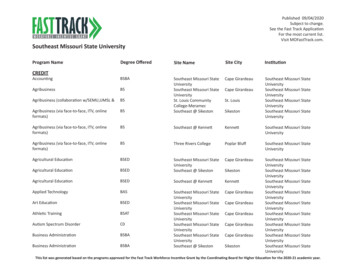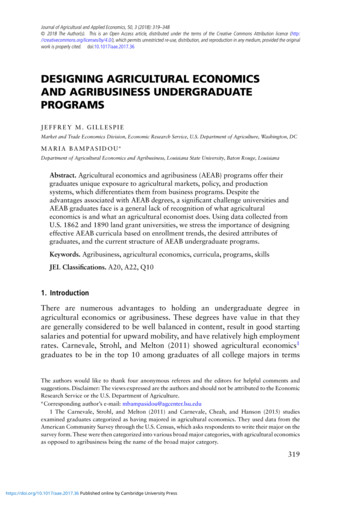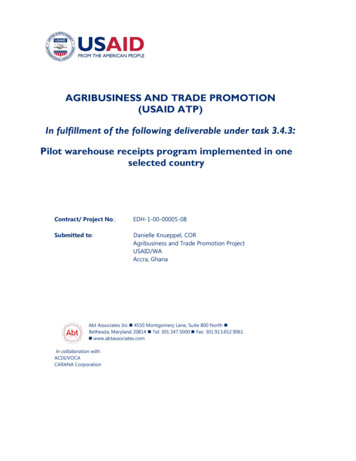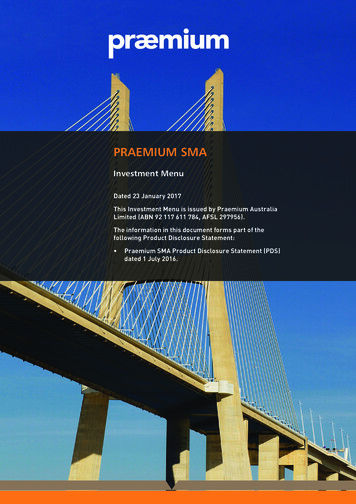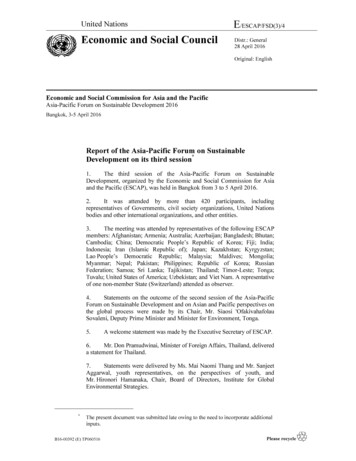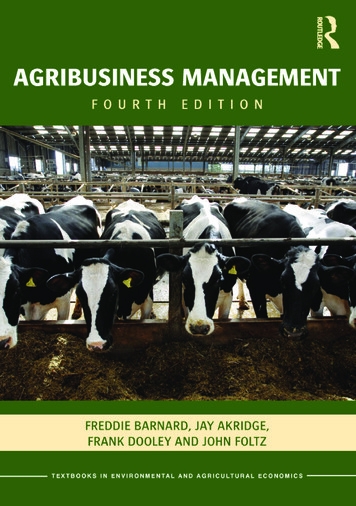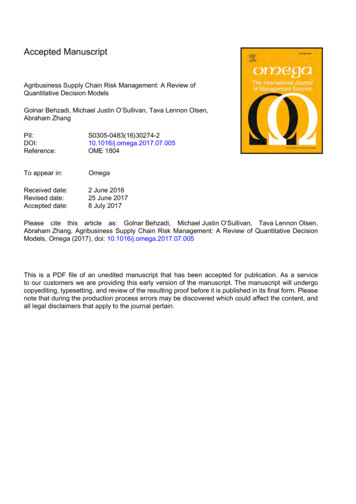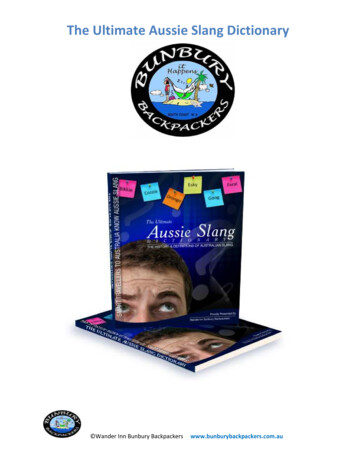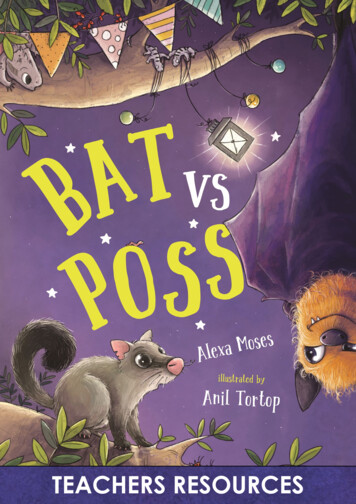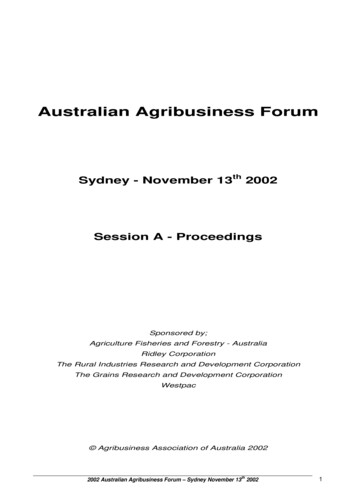
Transcription
Australian Agribusiness ForumSydney - November 13th 2002Session A - ProceedingsSponsored by;Agriculture Fisheries and Forestry - AustraliaRidley CorporationThe Rural Industries Research and Development CorporationThe Grains Research and Development CorporationWestpac Agribusiness Association of Australia 2002th2002 Australian Agribusiness Forum – Sydney November 13 20021
Table of Contents.Abstracts . 3The experience of New Zealand agricultural co-operatives in accessing global marketsDr Romuald E. J. Rudzki and Karla Davidson, Massey University New Zealand . 6The internationalisation of agricultural co-operatives – A source of conflict?Ignacio Donoso, Massey University New Zealand . 14The impact of the 1997 swine FMD outbreak in Taiwan on demand for Australian beefHui-Shung (Christie) Chang, University of New England, Armidale and Chung-Jen Hsia AgriculturalMarketing Division, Council of Agriculture, Taipei, Taiwan . 30Animal Product Consumption Trends in ChinaabbJi-Min Wang , Zhang-Yue Zhou and Rod Cox . 43Cost of production on New Zealand dairy farms; the impact of feed conversion efficiency and milk price.P Salles, N M Shadbolt, J Hodgson, C Holmes & P Matthews College of Science, Massey University . 64Efficiency Measurement of Australian Dairy Farms: National and Regional PerformanceMary Graham* School of Economics Deakin University and Dr. Iain Fraser Department of Economics andFinance La Trobe University. 73Decision aid to evaluate a change in feeding systems. A dairy case study on maize silage.Lloyd Davies, Economist, NSW Agriculture, Tocal Agricultural Centre. NSW . 88Weather and Climate Services for AgricultureIan Muirhead, Grant Beard, Barry Southern, Graham de Hoedt and Blair Trewin Steve Lellyett, Climate andConsultancy Services Manager NSW - Commonwealth Bureau of Meteorology . 93StockPlan - A drought decision tool for graziersLloyd Davies Economist, NSW Agriculture, Tocal Agricultural Centre. 102Who Can Help the Australian Sugar Industry?George Antony, Andrew Higgins and Mark Smith . 107th2002 Australian Agribusiness Forum – Sydney November 13 20022
AbstractsThe experience of New Zealand agricultural co-operatives in accessing global marketsRomuald Rudzki, Massey University New ZealandThe paper examines the operations of Fonterra (dairy industry), and Zespri (kiwifruit) in foreign trade. Casestudies are provided and key elements critically examined with conclusions drawn. A comprehensiveliterature review is included.The internationalisation of agricultural co-operatives – A source of conflict?Ignacio Donoso, Massey University New ZealandThe paper examines through a summary of a comprehensive literature review the internationalisation ofagricultural co-operatives globally. The review covers recent research on the areas of agricultural cooperatives, business internationalisation theory, and internationalisation of co-operatives, thereforerepresenting a comparison of the similarities and differences between the general business literature -mostlybased on the internationalisation of investor-oriented firms (IOF)- and the agricultural co-operativesspecialised literature in the topic of internationalisation. Starting with a review of the traditional definition ofco-operatives and their unique characteristics, the paper covers areas like: the emergence of new cooperative models, reasons for internationalisation as well as the barriers to it, forms of internationalisationadopted by co-operatives, and potential conflicts that can arise. The paper introduces two New Zealandorganisations, Fonterra Co-operative Group –a dairy pure co-operative-, and Zespri Group – a kiwifruit hybridco-operative- and examines through publicly available information their situation with respect tointernationalisation.Impacts of swine FMD outbreak in Taiwan on import demand for Australian beefHui-Shung (Christie) Chang, School of Economics, University of New EnglandIn March 1997, a FMD epidemic broke out in Taiwan and within four months 40 percent of pig populationwas wiped out. The demand for pork fell substantially following the outbreak due to food safety concerns.Because pork consumption accounted for almost one third of total meat consumption in Taiwan, averaging40 kg per person per year, for more than a decade, a significant reduction in pork demand could be expectedto lead to an increase in consumption of other meats, including beef. Further, because more than 90 percentof beef consumed in Taiwan is imported, mainly from Australia, New Zealand and the United States, apossible move towards beef seems to present an marketing opportunity for all beef suppliers to Taiwan,including Australia.The objective of this study is to determine the impact of the FMD outbreak, as well as other demand shifters,on the demand for Australian beef in the Taiwan market. The findings will be useful in the development ofmarketing strategies by the Australian beef industry to improve market position. To achieve the researchobjective, demands for beef imports from Australia, the United States and New Zealand were estimatedeconometrically based on monthly data from January 1990 to December 2001. The major finding was thatthe FMD outbreak had little impact on the demand for Australian beef export to Taiwan; New Zealand andthe United States fared only slightly better.Animal Product Consumption Trends in ChinaDr Zhang-Yue Zhou - Asian Agribusiness Research Centre, University of Sydney OrangeSince 1978, China's livestock sector has grown rapidly. Total meat output (including pork, beef, mutton andpoultry) reached 61 million tonnes in 2000, 5 times the output in 1978. Outputs of milk and eggs reached 9.2million tonnes and 22.4 million tonnes in 2000, about 7 and 9 times the corresponding output in 1978.th2002 Australian Agribusiness Forum – Sydney November 13 20023
Cost of production on New Zealand dairy farms; the impact of feed conversion efficiencyand milk price.Nicola Shadbolt, College of Science, Massey UniversityTraditionally, New Zealand dairy production has been based on high pasture utilization at high stockingrates, which resulted in low animal performance. Recently, a group of farmers in New Zealand graduallychanged their production policy to a high production per hectare system achieved through high animalperformance. These farmers concluded that this objective could be obtained by decreasing stocking ratesand utilizing supplements strategically, while still maintaining efficient pasture utilization. In a pastoralsystem the highest proportion of cost of production is that related to growing grass. If more grass is betterutilised through improved management practices, the cost per kg of milksolids is reduced. Research onthese farms identified a range of feed conversion efficiencies indicating varying feed utilization of thecombined pasture and supplement diet. Comparative analysis between these case study farms and the moretraditional systems identified differences in average cost of production and other key performance indicators.With a 30% drop in price for 2003, the paper analyses the impact of this on each system.Efficiency Measurement of Australian Dairy Farms: National and Regional PerformanceMary Graham, School of Economics, Deakin UniversityThe dairy industry is a major growth industry both in terms of value of output and as a major value addingand export industry. A nationwide survey of dairy farmers in 2000 conducted for the Dairy Research andDevelopment Corporation, provides the data base to which the linear programming technique, DataEnvelope Analysis (DEA) is used to explore the distribution of productive efficiency in the industry acrossAustralia and also within individual dairy regions. The efficiency scores attained will vary depending on thesize of the sample and the inputs selected in estimating the production frontier. In addition, regions vary insize and scale of operation and this raises the question as to what is the appropriate scale. This can varyfrom one region to another. The paper explains the linear programme and estimates the productive efficiencyof dairy farms for all Australia and for individual regions. Regions are also examined in terms of scale ofoperations to see if there is justification in the move towards bigger dairy production units than currentlyexist, given their factor mix.Dairy farmer decision aid for investment in fodder conservation equipment.Lloyd Davies, Economist, NSW Agriculture, Tocal.Dairy farming margins are generally small and the pressures to adopt new technologies to reduce costs areincreasing. Purchased feed costs is the major variable cost in dairying and currently averages 15 cents perlitre or around 60% of variable costs and 40% of total operating costs. Converting surplus spring pastureproduction or specialist fodder crops into silage or hay for feeding out in times of pasture shortage is a keystrategy considered by farmers to reduce fodder costs. However, a new fodder conservation strategyusually involves considerable machinery investment and other changes on the farm. A spreadsheet modelhas been developed to help farmers evaluate whether the projected benefits are greater than all of theadditional costs, including the overhead costs. The model allows the user to enter all relevant work rate andcost information and evaluates the proposed system using a partial budgeting approach.th2002 Australian Agribusiness Forum – Sydney November 13 20024
Climate and Weather Services for AgricultureIan Muirhead, Bureau of Meteorology“The north wind is best for sowing seed, the south for grafting”For many centuries weather folklore such as this has been used to aid decision making in agriculture. Thetrouble with weather proverbs is not so much that they're all wrong, but that they're not all right for all times inall places (Spencer, 1954). Improvements in science and technology have both improved the accuracy withwhich weather fundamental to farming can be forecast, and opened up a range of new products to improveefficiency and reliability within the agricultural sector – from crop planning to the marketing of produce. Thispaper discusses a number of products and services available from the Australian Bureau of Meteorologywhich have application in agriculture, and discusses the direction of potential advances in the next few years.Historical climate data, Forecasts and observations, Seasonal outlooks, Special services for agriculture,Weather risk prediction, Interaction with the agricultural community. The paper will conclude with a briefpresentation of selected case studies to illustrate some current applications of weather and climateinformation in agriculture. The talk will end with a short discussion on the latest developments in the El Ninocycle.StockPlan - A drought decision tool for graziersLloyd Davies, Economist NSW Agriculture, TocalStockPlan is a suite of computer decision support tools that enable cattle and sheep producers exploremanagement options in the early stages of drought and during drought. The main aim of these decision toolsis to assist producers make management decisions, which minimise the environmental and financial impactsof drought. Management options are explored through three StockPlan tools: Drought Pack, Im Pack andFSA Pack; and helpful advice through seven StockPlan links: Introduction, Decision-making Process,Drought and Over Grazing Issues, Animal Health and Welfare, Climate, Bob's Story and "Where to get help".An optional hot key is also available to connect users to the NSW Agriculture Drought Web site. DroughtPack provides a ‘user-friendly’ snapshot of the financial consequences of management and feedingstrategies for sheep and cattle enterprises through a projected period of limited pasture. FSA looks at thelikely financial consequences of feeding, selling and agisting a specific class of stock. Im Pack is a herd orflock model that can plan and track stock numbers up to 10 years in advance. It calculates breedingnumbers, the numbers available for sale their impact on the cash flow.Who can help the Australian sugar industry?George Antony, CSIRO Sustainable Ecosystems, Tropical Landscapes ProgramThe Australian sugar industry’s latest crisis is more than another temporary price downturn: the Braziliansare riding roughshod in the export markets, environmentalists are circling at home, and governments aremuch cooler about offering cash assistance than they used to be. Who can help the industry, then ? Weargue that only the industry can help itself, through major restructuring, and there are promising options fordoing so. In better times, preference for pervasive industry regulation caused potential gains to be missed.Now it may lead to bankruptcy if it prevents the adoption of new ways. Up until the mid-1990s, the Australiansugar industry was the international leader in technology and costs, making most of such componentoriented improvements as new varieties and harvesting technology that did not require systemic changes.However, these are no longer sufficient to maintain international competitiveness, as they do not addresscostly inefficiencies in the supply chain. Advances in whole-of-system analysis and a build-up of region-wideindustry data have created new analytical capabilities to support better supply-chain integration, with thepromise of quick returns. Applying a broader perspective, horizontal integration with other activities in theregion has the long-term promise of creating more flexible diversified farming and processing systems.These could achieve higher value adding, improve the economic efficiency and resilience of sugarcanebased production systems and, contrary to received wisdom, enable win-win outcomes from pro-activeenvironmental management.th2002 Australian Agribusiness Forum – Sydney November 13 20025
The experience of New Zealand agricultural co-operatives in accessing globalmarketsDr Romuald E. J. Rudzki and Karla Davidson,Massey UniversityNew Zealand1. IntroductionIt is essential to understand the importance of history in shaping agriculture within New Zealand. Sinclair(2000) describes the development of the country which began with the first migration to the islands between1100 and 1400 AD by Polynesians seafarers who called the islands Aotearoa (Land of the Long WhiteCloud). Early evidence of agrarian communities can be seen in the kainga (villages) with their neighbouringkumara plantations. Westernisation of the islands occurred following their sighting in 1642 by DutchmanAbel Tasman who named them Nieuw Zeeland after the Dutch province of Zeeland. His attempts to landwere rebuffed by Maori warriors who killed a number of his crew. The subsequent exploration and mappingof the coastline by the English Captain James Cook in 1769, 1772 and 1776 and his contact with Maori ledto his claiming the islands for the British Crown. The Dutch East India Company in their search for the greatsouthern continent had funded Cook, which had been predicted. With the establishment of Australia as apenal colony, New Zealand was attractive firstly to sealers and then to whalers, who introduced the worstaspects of pakeha (white man) influences to the Maori population including firearms, prostitution andalcoholism. Armed with the new muskets, Maori tribes engaged in inter-tribal warfare with devastating effectsleading to a declining Maori population.The attractiveness of the lush and fertile New Zealand contrasted to the hot and arid landscape of Australiawith waves of land speculators, farmers and sundry other groups moving to colonise the islands. Of these,the most significant was Edward Gibbon Wakefield, a social theorist who wanted to use New Zealand as thetesting ground for his theory of “scientific colonisation” by preserving English class structures of the village bytransferring a cross-section of society but without the “dregs” at the bottom. He hoped thereby to recreatethe rural idyll, which would ensure continued land ownership by the gentry and continued labouring by theworking class who would be unable to purchase land due to its high cost relative to the income produced.It is estimated (Harper et al, 1998) that “Between 1839 and 1847, the New Zealand Company dispatchednearly 19,000 settlers and established them in “planned settlements” in Wellington, Wanganui, Nelson andNew Plymouth. This was the core of pakeha immigration, with the only substantial non-Wakefield settlementbeing Auckland.” (P.765).Orange (1992) provides a detailed account of the signing of the Treaty of Waitangi in 1840. This definingmoment in New Zealand history saw the Maori chiefs surrendering sovereignty to the British Crown inexchange for citizenship, privileges, and duties enjoyed by British subjects as well as land and fishing rightsin perpetuity. Maori were only allowed to sell land to the Crown who would then sell it on to the purchasersat substantial profit. The Wars that followed (Bellich 1988) have been variously described as the ‘MaoriWars’, ‘New Zealand Wars’ or ‘te riri pakeha’ (‘white man’s anger’) and spanned the period between 1860and 1881 when peace was finally declared. These were probably the darkest years in New Zealand’s historyas the Treaty terms were disregarded in favour of economic exploitation seen in the deforestation of thecountry and the growth of the agricultural sector particularly in sheep farming (both meat and wool) and thedairy industry (for produce and hides).Treaty Claims as to land ownership and the correct interpretation of the Treaty are still issues current todayand define the landscape in terms of land ownership, fishing and hunting rights, forestry and the extensiveagricultural and horticultural developments that have occurred with the introduction of dairy cattle byimmigrant farmers and (in 1851) viniculture by French Ctholic Marist missionaries.The first use of refrigerated shipping in 1882 allowed extensive sales of New Zealand products andespecially lamb, to Great Britain that continued for close on a century until the 1970s. This agricultural baseto the economy served New Zealand well, particularly in its favoured agreements to supply the UnitedKingdom with lamb and butter. These Agreements held until Britain’s accession to the European Communityin 1973, when New Zealand had to find new markets for its products.Grant (1996) describes the period of wholesale implementation of free market principles in the 1980’s. Thiswas unusual for a Labour government anywhere in the world and was popularly called ‘Rogernomics’ afterits chief driving force, the Finance Minister Roger Douglas. Withdrawal of subsidies meant that New Zealandagricultural products became competitive on the global market with aggressive expansion of exports.th2002 Australian Agribusiness Forum – Sydney November 13 20026
The signing in 1983 of the Closer Economic Relations Trade Agreement between New Zealand andAustralia allowed free and unrestricted trade.In 1984 New Zealand adopted a ‘no-nuclear’ policy, which led to US withdrawal from the ANZUS defencepack aimed at preventing the spread of Communism in the period of the Korean war (1950-1953) onwards.The GATT Uruguay Round Agriculture Agreement of 1994 with its requirement for reduction of subsidies toagricultural production and exports meant that New Zealand was well-placed to take advantage of free tradein the globalized agricultural industry as described by Le Heron (1993) and agricultural co-operatives (Cobia,1989).stOn the 1 March 1998, a new combined Ministry of Agriculture and Forestry (MAF) was formed out of theMinistry of Agriculture and the Ministry of Forestry with a remit to: “help the government create anenvironment allowing the food, fibre and timber industries make the best contribution to sustainableeconomic growth and environmental quality, while managing risks to human, animal and plant health andsafety, and to resources.”In 1999 the MAF Regulatory Authority was separated into the Biosecurity Authority and the Food AssurancestAuthority. The decision of October 1 2002 to allow the use of human genes in cattle does not bode well forNew Zealand’s organics industry with an estimated value of NZ 80 million as well as for the ‘Clean andGreen Godzone’ image, which is of such value for the tourist industry. The traditional industries are nowbeing supplemented with new additions aimed at New Zealand’s most important markets in the USA, Japan,Australia, the United Kingdom, China and South Korea, in such areas as forestry, horticulture, fishing,manufacturing, wine production and tourism.2. The New Zealand Agricultural, Forestry and Horticultural sectorsMAF (2002) provides a useful summary of statistics relating to the sectors within New Zealand for the yearending March 2002. Agriculture is defined as meat and meat products, dairy products, wool, and otherpastoral based products excluding horticulture, which includes vegetables, fruit and nuts together withpreparations thereof. Employment within agriculture was 115,040, with a further 32,660 in horticulture and24,315 in forestry of a total population of around 3.8 million and of a total working population of 1,727,268.Total exports for the three areas were valued at 20.6 billion and accounted for 66% of New Zealand’s totalexports. The top export destinations are shown below in Table 1.Within the various sectors, the Producer Boards are responsible for various functions as described by MAF(2000). The Boards are ENZA (apple grower), Fonterra (dairy), New Zealand Federated Farmers, NewZealand Game Industry Board, New Zealand Hop Marketers, New Zealand Meat Producers Board, NewZealand Wool Group, Pork Industry Board, Poultry Association of New Zealand, Wools of New Zealand, andZespri International Limited. Enderwick and Akoorie (1996) provide detailed case studies of many of the keyproducer boards responsible for the development of agricultural exports within New Zealand, including theNew Zealand Dairy Board, New Zealand Venison, New Zealand Kiwifruit Marketing Board, WoolrestInternational, Tenon Developments, and the Forestry Corporation of New Zealand.Table 1: Top Export Destinations in terms of sales (NZ m) for year ended December 2001(provisional values in NZ m free on board)CountryUSAJapanAustraliaUKChinaSouth elgiumIndonesiaHong 509.8509.550042631019616315.6Source: MAF (2002)th2002 Australian Agribusiness Forum – Sydney November 13 20027
3. New Zealand Agricultural Co-operativesThe first co-operatives were farmer trading co-operatives established in 1881 in Timaru and Christchurchwith further co-operatives arising as the benefits of having lower cost supplies and regular purchases forproduce became self-evident.The present day New Zealand Co-operative Association (NZCA) is an umbrella organization, which wasestablished for agricultural co-operatives but after changing its constitution, now allows non-agriculturalmembership. Currently it has 33 co-operatives as members.Within the dairy industry the co-operatives include Fonterra (which is New Zealand’s largest company) andother dairy co-operatives including Westland and Tatua. Tatua is a New Generation co-operative aiming tomaximize added value to the commodity. The success of this approach can be seen in the way Tatua paidout 6.80 per kilogram of milk solids in the last financial year compared to Fonterra’s 5.30.In the meat industry the co-operatives include PPCS and Alliance, with both AVCO and Richmond havingchanged their co-operative status to a corporate one.In the horticultural sector, Zespri is a hybrid co-operative with 12 supplier companies of which 5 are cooperatives. ENZA is the co-operative of apple-growers.The wool sector has recently seen (October 2002) the formation of the largest wool co-operative known asthe Primary Wool Co-operative Limited with a projected turnover of 50million in its first year. This wasformed from the Dannevirke-based East Coast Wool Co-operative with 400 shareholders and the wooldivision of Christchurch-based Combined Rural Traders (CRT) with 9000 shareholders. This new cooperative becomes the second largest procurer of wool in New Zealand.The two short case studies that follow - of Fonterra and Foodstuffs – represent in many ways the twoextremes of globalisation, with Fonterra as New Zealand’s largest company competing successfully on theglobal stage and Foodstuffs fighting to protect its domestic market share from foreign competitors.4. FonterraThe largest of the co-operatives is Fonterra with membership of over 13,000 farmers (Fonterra AnnualReport. 2001). Fonterra is also New Zealand’s largest company and foreign currency earner.New Zealand has one of the world’s most market-oriented agricultural policies. Since the radical reforms ofthe agricultural sector in 1984, the level of agricultural subsidy in New Zealand has been practically nonexistent and New Zealand is now virtually a "free trade" country. This has resulted in New Zealand milkproducers being among the least regulated in the world, able to produce without any constraints on milkproduction.The global dairy industry, according to Promar International (2000), is both large and very dynamic. Worldconsumption of dairy products is currently estimated at 539 million tonnes per annum and is forecast to growat an annual rate of 1-2% to 2005.Furthermore, the world dairy industry is a multi billion-dollar industry made up of several major players. Sincethe 1980s, recent trends in the global dairy industry have been deregulation, and increasing globalisation. Infact, globalisation has been the driving force for the large number of mergers and take-overs among dairycompanies recently (Rabobank, 2001).Fonterra - founded in 2001 - is a New Zealand owned and based co-operative company, with earnings ofNZ 13.9 billion in dairy sales in the year to 30 June 2002(Fonterra Annual Report, 2002). Fonterra has group operations in around 120 countries, and was rankedfourth in Rabobank’s 2002 list of world top dairy companies.The New Zealand dairy industry is export oriented with more than 95% of milk produced on New Zealanddairy farms being used for export. This contrasts with most other countries, where the majority of milk isconsumed domestically. This reflects not only New Zealand’s relatively small population of 3.9 million, butalso the size of the country’s dairy sector, with over 13,000 dairy farmers.Fonterra has segmented its business into four broad product groups: cheese, cream and associatedproducts, milk powders, and protein – which encompasses casein and whey. The company has alsosegmented global business into five regions, within which New Zealand is considered a separate, domesticregion:(1) ASIA - including both South and North Asia, China, Hong Kong, the Philippines, Malaysia, Indonesia,Japan, Korea, and Indiath2002 Australian Agribusiness Forum – Sydney November 13 20028
(2) AIME – including Africa and the Middle East: Saudi Arabia, Pakistan, Iran, Iraq etc(3) AMERICAS – including both North and South America, Mexico, and the Caribbean(4) AUSAPAC - Australia and the Pacific(5) EUROPE - including RussiaThe New Zealand dairy industry set its sights on export very early, and was in fact exporting cheese andbutter from Canterbury to Australia in the 1840s. When refrigerated shipping was invented in 1882, exportsof butter and cheese were expanded to Britain, South Africa and other distant markets (Xu, 1998, p. 22).In the early exporting days, each dairy manufacturing company marketed its exports independently. Somebigger companies set up agencies overseas to sell their product, such as Amalgamated Dairies, which wasset up in London by the New Zealand Co-operative Dairy Company.In 1923 the Government established the Dairy Produce Export Board – which became known as the ‘DairyBoard’ – to act as the central export seller. The New Zealand Dairy Board (NZDB) was established in 1961under the Dairy Board Marketing Act. This Act gave it monopoly rights over the purchasing and marketing ofall export dairy products from New Zealand. A detailed account of the New Zealand Dairy Board is providedby Enderwick and Akoorie (1996).Historically the United Kingdom was one of the Dairy Board’s most significant export markets. Under a bulkmarketing arrangement, the UK paid premium prices for more than 90% of New Zealand’s dairy produce, ina bid to counter wartime food shortages during World War II (Webb, 1995). The UK bulk purchaseagreement ended in 1954, however the New Zealand dairy industry remained very dependent on the UKmarket for the next few decades.As discussed by Xu (1998), the threat of British entry to the European Community (EC) in 1973 prompted amove to find new markets for New Zealand’s dairy export. Around this time the Dairy Board started toimplement some strategies which have been drivers of th
2002 Australian Agribusiness Forum - Sydney November 13th 2002 1 Australian Agribusiness Forum Sydney - November 13th 2002 Session A - Proceedings Sponsored by;
